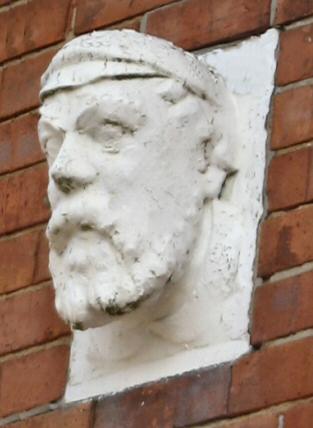|
Roads
Origins of Winton road names
Peters Hill is believed to have been so called because
the spire of St. Peter's Church could be seen from it. Another
explanation is that it got its name from an old man called Peter
who at the beginning of the 20th century had a naptha-lit stall
decked with tin kettles, mats, brushes and other hardware. The
locals called his pitch on the hill “Peter's Dump”.

Charles Burt was a prolific Victorian
builder in Winton. He had this plaster cast of his head set
in the wall of a house in Cardigan Road |
Smithfield Place used to be called Burden's Place
- Henry Burden, Grocer and Draper, kept shop there in the 1870s
and 80s. By the end of the century the shop had changed hands
and was owned by George Newitt, before becoming Claytons, and
keeping that name for the next forty-odd years. By the mid 1890s
blacksmith William George Tuck had come to the Place, which probably
accounts for its change of name.
Calvin, Cranmer, Latimer, Luther, Ridley and Wycliffe
Road are all named after Protestant churchmen.
MacWilliam Road, off Malvern Road, bears the name
of James McWilliam - a builder and leading Congregationalist who
represented the area on the newly created Hampshire County Council
and advised the Talbot Estate on some of the building development
in Winton and Moordown. At the end of the road is a thatched cottage
which is the oldest house in the two villages.
Pine Road may have been so named because it led
past one of the new pine plantations.
Heron Court Road was named after Heron later Hurn
Court on Lord Malmesbury's estate near Holdenhurst.
It is likely that Castle Road was renamed from Post
Office Road because it led roughly via Gresham Road and East Way
to Castle Lane, which, in turn, led to Highcliffe Castle.
Road names like Dunbar , Dunkeld and Glenfirness
were chosen to reflect the Scottish ancestry of the Talbot sisters,
and former Talbot Woods landowner, Lord Leven.
Alma, Waterloo and Trafalgar Roads are named after
battles. Cardigan Road is named after Lord Cardigan who led the
Charge of the Light Brigade in the Crimean War.
Others who gave their names
to roads:
Hankinson Road was named after Bournemouth's first
Mayor, T. J. Hankinson.
Truscott was named after Sir Francis Wyatt Truscott, Lord Mayor
of London , who opened the pier.
Abbott and Luckham were Aldermen.
Bemister was a local businessmen.
Frampton was named after Charles Frampton, first and only chairman
of the short-lived Winton Urban District council (1898-1901).
Rev. Herbert Bloomfield was a popular vicar of St. John 's for
many years.
Fitzharris was the title of the eldest son of Lord Malmesbury.
Roads renamed
The new portion of Brassey Road (formerly Church
Road) was called Sherbourne Road and the corresponding part of
Castle Road (formerly Post Office Road) and of Pine Road were
Sarum and Frances Roads with York Road (now Merley) to the east.
Crichel Road was Arlington Road and Melville Road
was Gordon Road. Nelson was replaced by Markham, and what are
now Strouden and Hawthorn Roads were Wynyard Road and Laundry
Place. Bournemouth Steam Laundry in Post Office Road was the precursor
of the large Castle Laundry.
Ensbury Park Road was originally Muccleshell, Maccelshell
or Muggleshell Lane although it does not run in that direction.
|